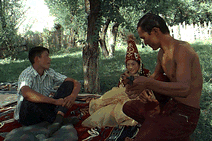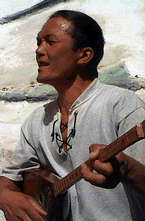Posts Tagged interpreter
Day 33 – another half-ready kobuz nestled like a hibernating wild animal
Posted by Musical Nomad in Daily Blog on August 30, 1997

“It looked like a tree trunk”
For some time now we have been traveling from one Central Asian city to the next, in search of sometimes elusive musicians. It comes as something of a shock to find myself in dramatic mountain scenery within an hour of leaving Almaty. Seemingly vertical surfaces of rock carry the eye upward, to the hazy skyline.
We are camped by a stream in a beautiful valley, this feels like the first opportunity I’ve had to reflect on our journey. Thirty days on the road is a long time in some ways, but it has been a whirlwind tour. I would have been happy to spend weeks visiting any one of the musicians we’ve encountered. I have the impression of being allowed a brief glimpse into a fascinating and absorbing world.
Thinking about Raushan’s kobuz playing yesterday, its directness and simplicity, I felt the urge to improvise a piece about being here in the mountains. I have with me a simple three-holed flute from Africa, which seems the perfect instrument. It’s not every day you get to play in a concert hall like this. The wind carries the sound away very quickly and I feel small in such a vast location. It seems appropriate though – being here gives a sense of perspective on life.
 We had been told that the ‘village of the masters’ was one hour from Almaty. When Nomadmobile 4 set off we were unreliably informed that the village was over a 3000 metre pass. Looking forward to a spectacular ride through the Alatau mountains the Musical Nomad cavalcade started up. After what seemed like twenty minutes we turn off the main road across a small stream and up a steep rocky slope. Two large yellow apartment blocks and a small row of houses nestle in an avenue of electricity pylons. “This is the masters village” the driver informed us. My image of wooden shacks on a wooded hillside was immediately shattered. As soon as we switched off the engine several men began to display carpets and silver ware in the road outside the larger of the two apartments. The crafts are good quality and I bought a rug. Gradually a crowd of village children gathered and we become the centre of attention on a dull Saturday afternoon. They were confused by our presence – this place obviously doesn’t get many visitors.
We had been told that the ‘village of the masters’ was one hour from Almaty. When Nomadmobile 4 set off we were unreliably informed that the village was over a 3000 metre pass. Looking forward to a spectacular ride through the Alatau mountains the Musical Nomad cavalcade started up. After what seemed like twenty minutes we turn off the main road across a small stream and up a steep rocky slope. Two large yellow apartment blocks and a small row of houses nestle in an avenue of electricity pylons. “This is the masters village” the driver informed us. My image of wooden shacks on a wooded hillside was immediately shattered. As soon as we switched off the engine several men began to display carpets and silver ware in the road outside the larger of the two apartments. The crafts are good quality and I bought a rug. Gradually a crowd of village children gathered and we become the centre of attention on a dull Saturday afternoon. They were confused by our presence – this place obviously doesn’t get many visitors.
 A man resembling Shayhk Kushkarov of Day 20 suddenly appeared and amongst his Kazak I recognise the word kobuz. I say Raushan’s name and immediately we have connected. The housing block is home to a community of craftspeople. Tolegen Sarsenbaev, the kobuz maker invites us in to his simple abode. He has a very friendly face, bearded with deep passionate eyes. I immediately sensed his creativity and devotion to his craft. This was a man used to working in harmony with nature. Three large rooms operate as workshop, bedroom , living room, artist studio and kitchen. A tree-trunk in his studio serves as a stand for his musical instruments which he says charges them with energy . He seems to understand why we have come and begins laying out half made kobuz’s all over the living room floor. They look wonderful. Variations on a theme for sure but in their raw state they have an embryonic perfection, living things almost ready. Another partially ready piece which caught my attention was a kobuz case. This looked like a tree trunk and inside another half ready kobuz nestled like a hibernating wild animal.
A man resembling Shayhk Kushkarov of Day 20 suddenly appeared and amongst his Kazak I recognise the word kobuz. I say Raushan’s name and immediately we have connected. The housing block is home to a community of craftspeople. Tolegen Sarsenbaev, the kobuz maker invites us in to his simple abode. He has a very friendly face, bearded with deep passionate eyes. I immediately sensed his creativity and devotion to his craft. This was a man used to working in harmony with nature. Three large rooms operate as workshop, bedroom , living room, artist studio and kitchen. A tree-trunk in his studio serves as a stand for his musical instruments which he says charges them with energy . He seems to understand why we have come and begins laying out half made kobuz’s all over the living room floor. They look wonderful. Variations on a theme for sure but in their raw state they have an embryonic perfection, living things almost ready. Another partially ready piece which caught my attention was a kobuz case. This looked like a tree trunk and inside another half ready kobuz nestled like a hibernating wild animal.
 Tolegen told me that most of his kobuz’s are designed on the theme of wild animals. He had a bird, a camel and a owl. The profile of the instruments were indeed animal-like. Tolegen described the shape of the soundboard, which on most instruments resembles a heart with a trench underneath. He said this helped the sound to flow from the bottom of the instrument into the centre enabling it to project forwards. He seemed enthusiastic to talk about the technical aspects of his work. I asked him about Raushan’s instrument, particlarly the fingerboard and the lifted nut. He said this was an experiment many years ago and Raushan had requested it particularly for her ‘cuticle’ technique we mentioned yesterday. He was keen to talk about the uses of his instruments and mentioned how the kobuz is a favourite of Shaman for inducing trance like states. He didn’t have a finished instrument to play to us so I showed him my kyl-kyiak which produced some amusement. He refused to play it saying it was ‘imitation kobuz’ So much for Kazak-Kyrgyz relations.
Tolegen told me that most of his kobuz’s are designed on the theme of wild animals. He had a bird, a camel and a owl. The profile of the instruments were indeed animal-like. Tolegen described the shape of the soundboard, which on most instruments resembles a heart with a trench underneath. He said this helped the sound to flow from the bottom of the instrument into the centre enabling it to project forwards. He seemed enthusiastic to talk about the technical aspects of his work. I asked him about Raushan’s instrument, particlarly the fingerboard and the lifted nut. He said this was an experiment many years ago and Raushan had requested it particularly for her ‘cuticle’ technique we mentioned yesterday. He was keen to talk about the uses of his instruments and mentioned how the kobuz is a favourite of Shaman for inducing trance like states. He didn’t have a finished instrument to play to us so I showed him my kyl-kyiak which produced some amusement. He refused to play it saying it was ‘imitation kobuz’ So much for Kazak-Kyrgyz relations.
 We also talked about Tolegen’s passionate interest in Shamanistic rituals and his recent meeting with a Shaman, Temish, in Kyrgyzstan at Lake Issyk-Kul. He met Temish when he stayed in the house of Ama, an ‘old and wise babushka’ who is teaching Temish all about the ancient traditions of zikr and Shamanic dances. Tolegen is now making a kobuz for Temish this is the instrument that Shamans used to play in Kazakstan and Kyrgyzstan during zikr’s. I was surprised to hear of Shaman rituals which include zikr. Zikr is an Arabic word used to describe a specific Sufi practice. Perhaps this supports Shaykh Kushkarov’s assertion that the two traditions are connected in Central Asia.
We also talked about Tolegen’s passionate interest in Shamanistic rituals and his recent meeting with a Shaman, Temish, in Kyrgyzstan at Lake Issyk-Kul. He met Temish when he stayed in the house of Ama, an ‘old and wise babushka’ who is teaching Temish all about the ancient traditions of zikr and Shamanic dances. Tolegen is now making a kobuz for Temish this is the instrument that Shamans used to play in Kazakstan and Kyrgyzstan during zikr’s. I was surprised to hear of Shaman rituals which include zikr. Zikr is an Arabic word used to describe a specific Sufi practice. Perhaps this supports Shaykh Kushkarov’s assertion that the two traditions are connected in Central Asia.
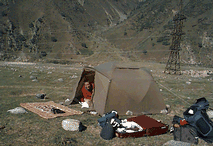 Tolegen is keen to join a zikr next month for which he will hike across the river Yur-Kemin and the Kungey Alatau mountain range (over 4000m high) into Kyrgyzstan and then hitch a lift along Lake Issyk-Kul. I’m interested to know which of the instruments I’ve seen in his workshop is intended for Temish – I’m told he chose one shaped like a bird in flight – a metaphor for the animal spirit.
Tolegen is keen to join a zikr next month for which he will hike across the river Yur-Kemin and the Kungey Alatau mountain range (over 4000m high) into Kyrgyzstan and then hitch a lift along Lake Issyk-Kul. I’m interested to know which of the instruments I’ve seen in his workshop is intended for Temish – I’m told he chose one shaped like a bird in flight – a metaphor for the animal spirit.
As we make camp a competition soon emerges for best attempt at rigging a tent. Paul’s team wins hands down, predictably with help from the girl guides. I take advantage of the ‘cold and cold’ running water and avail myself of that handy bush. Gary is in seventh heaven as he plays his Krygyz Komuz and rigs his satellite next to his tent. His feet grounded in the stream, at last a long way from a power point.
As the evening shadows shape new contours into the eternal hills, this is definitely a place to make music. I’m sure tomorrow will bring us closer to the nomad spirit of these Kazak people. We will camp near some mountain villages and via our new interpreter Moldira attempt a dialogue with their remote inhabitants. The musical nomad has truly landed….. ‘When you sleep outside your thoughts are as high as the stars’.
Day 32 – Where there is spirit there is usually music
Posted by Musical Nomad in Daily Blog on August 29, 1997
What oppression causes such sad faces in Almaty? In the hotel reception everyone glowers when you request directions to an urgently needed toilet. When I turn up for breakfast (the other half of bed and breakfast?) I’m marched off to reception where 8 dollars is demanded, cash, now! I smile at a floor manager (each floor of the hotel still has a KGB style ‘watchdog’). She glowers back uncomprehendingly. I point out my bathroom has no water to a hotel supervisor, she glowers at me for interrupting her chat with her friend. I assume this is all the legacy of the Soviet years – it will take a long time to heal these wounds.
Music is the food of the spirit. Outside of the modern cities that spirit seems more alive – perhaps further from beaurocracy and dogma?
In our absence no progress has been made on our proposed Yurt stay, we’ve been out of touch as Kyrgyzstan has no external phone service worth mentioning. We only have a few hours to organise this expedition.
Raushan Obrazbaeva – part two
What of music? One of my favourite musicians so far is Raushan, the hypnotic exponent of the kobuz. Her inspirational performance (Day 4) has remained a high point of the trip. I remembered she had spoken of musicians in the mountains. Perhaps she could help solve our predicament. I was also keen to ask her some more questions in the light of our experiences elsewhere in Central Asia.
In a small and rather noisy cafe in downtown Almaty we showed her how our Internet project had progressed. She was keen to hear Barkut (Day 29) the Kyrgyz kyl-kyiak player. Unfortunately, we did not include this track in our report but I showed her the instrument I had bought from him. Raushan was curious to play what she described as a Kyrgyz variant of the Kazak kobuz. She pointed out some significant differences in design, and sound. Unlike Western instruments, which are very standardised, Central Asian instruments vary widely. Kathy had also bought a Kazak kobuz, which was very different from either Raushan’s instrument or the Kyrgyz kyl-kyiak. The basic design of two string horse hair fiddle is constant – after that it seems to be up to the creativity of the maker. One of the main things Raushan pointed out about the kyl-kyiak was the different playing technique. She plays by pressing her cuticles on the strings like an Indian sarangi player (also a vertical fiddle but with sympathetic strings). The Kyrgyz players press on the strings with the fingertips. These differences are generalisations and there are pieces in the Kazak repertoire that demand different techniques.
“She plays with her cuticles”
Our conversation continued as we moved to the park to record Raushan in the open air – where she likes to play. [Also see Kurmangazi day 28]. She demonstrated some pieces that are inspired by animals – the wolf and the camel. I found myself astonished once again at the variety of expression that Raushan has, literally at her fingertips. Her instrument is close to nature in its simplicity. It produces a complex ‘unpurified’ sound with strong overtones. Raushan’s impressionistic renderings of animal sounds are very abstract in character, simultaneously ancient and modern.
Raushan also likes to play pieces from the European Classical repertoire, and she showed us how she changes the way she holds her bow to emulate a ‘cello. We could have chatted for ever about instrument design and playing techniques. We were conscious though that we had an expedition to organise and so time was short.
A kobuz masterclass and interview
Raushan told me of a village in the foothills of the Alatau Mountains only one hour away from Almaty – ‘The village of craftsmen’. Everyone there is a crafts person – the men making musical instruments and the women making clothing and jewellery. An instrument maker in this village had made her kobuz and she seemed delighted by my interest. It sounds like a beautiful area and apparently we can camp there overnight. Another region she recommends is a 6 hour drive away. This valley surrounding the Shinishke river has ‘real’ Kazak villages with people who still live in traditional ways. There are Yurt encampments – Nomadic herders settling in the rich pastures for the summer months. There is natural beauty. Thirteen thousand foot mountains, white water rivers and rare wildlife such as Ibex and Bobcat. Most importantly, Raushan told us that where there are people there is always music. She reiterated that Kazakstan is a very musical country. Suddenly our trip tomorrow is looking like an exciting adventure.
Raushan had given us some useful leads but we had a very short time to put the wheels into motion. This final week was meant to be a voyage of discovery and we seemed to be steering in the right direction. Nomadmobile 4 has to be organised – this time though we will be self-sufficient, living remotely, eating from carried supplies often miles from anywhere ‘civilised’. The electricity generator will now become our most important piece of eqipment as we send you daily episodes from deep in the mountains.
Jan ‘older and wiser’
Our Kazak interpreter Mary knew of an agency who were allegedly experts in the expedition field. Visiting their premises inspired some confidence. A large ‘ordnance survey’ style map of South East Kazakstan proudly enveloped one wall. In another room professional climbing and camping equipment. They seemed sympathetic to our requirements and listed everything we would require as we told them of our needs. We talked vehicles. Their first suggestion of a decrepit bus was soon jettisoned – the seats were lose, the bodywork crumbling and the wheels buckled. We stipulated two ‘modern’ Gazelle vans which would accommodate the Nomad team, cook, interpreter and drivers. There was also a lengthy conversation about safety. If we were in danger or someone was ill do we have a 24 helicopter rescue number? – they told us no general Kazak ‘mountain rescue’ service existed but the agency had a helicopter for emergencies. As the hours went on we realised we would have to furnish many ‘expedition’ items ourselves. A desperate rush around Almaty’s bazars and prestige shops then ensued. Gary, Paul and myself haggling with old women over the price of cheese and pears. On our way back through the commuter streets of Almaty, white shopping bags in hand we at last felt at one with the city – the locals around seemed to accept us. A pity that tomorrow we finally say good-bye to this, our most familiar city.
Tomorrow we head for the village of the masters, then on into unknown territory, little visited villages of Nomads and Yurts. Music? Who knows. Usually where there is spirit there is music
Day 29 – Home Cooking on the Road to Issyk-Kul
Posted by Musical Nomad in Daily Blog on August 26, 1997
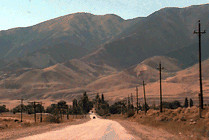 My journey covers over 3500 miles mostly by road. Today I set out for Lake Issyk-Kul, a resort area famous for its mineral rich water. I am told the road is bad. Nomadmobile 2 has left us and I anxiously wait to see how much further we can descend into highway hell. With trepidation I look-out from our apartment and behold an apparition. A brand new Chevrolet Winnebago mobile home – it even has a fridge! The only problem is our ton of satellite equipment – this is precariously balanced in a plywood bulkhead over my head. One bump too many and I’m an ex-Nomad.
My journey covers over 3500 miles mostly by road. Today I set out for Lake Issyk-Kul, a resort area famous for its mineral rich water. I am told the road is bad. Nomadmobile 2 has left us and I anxiously wait to see how much further we can descend into highway hell. With trepidation I look-out from our apartment and behold an apparition. A brand new Chevrolet Winnebago mobile home – it even has a fridge! The only problem is our ton of satellite equipment – this is precariously balanced in a plywood bulkhead over my head. One bump too many and I’m an ex-Nomad.

On the way to Balykchy to meet our musician Saparbek Kasmambetov we stopped off for a visit at Barchagul’s house (the mother-in-law of Gulnaz our interpreter). I always enjoy visiting local houses as it gives the truest insight into the way of life. Barchagul invited us in for chai, which turned out to be chai, bread, chips, jam, yogurt, bread etc. We should have guessed by now.
Barchagul is a special lady. Besides being a doctor she lives in a typical rural house and keeps sheep, chickens, rabbits as well as growing fruit and veg. 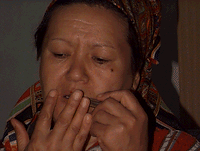 The gardens are full of produce and conserves and pickles were being made in readiness for the winter. No doubt the family work very hard but it is an enviable life. All the food is fresh, the bread homemade and the milk straight from the cow. Barchagul played us her jaws harp (Krygyz call these temir ooz komuz). The jaws harp was kept in a beautiful wooden box handmade by her husband. As we left their house laden with apples and pickles, Barchagul presented the instrument to Kathrin, saying ‘it’s a women’s instrument’. Once again the hospitality overwhelms us.
The gardens are full of produce and conserves and pickles were being made in readiness for the winter. No doubt the family work very hard but it is an enviable life. All the food is fresh, the bread homemade and the milk straight from the cow. Barchagul played us her jaws harp (Krygyz call these temir ooz komuz). The jaws harp was kept in a beautiful wooden box handmade by her husband. As we left their house laden with apples and pickles, Barchagul presented the instrument to Kathrin, saying ‘it’s a women’s instrument’. Once again the hospitality overwhelms us.
I am soon engulfed in beautiful precipitous mountains, blue and snow capped. To the left a desert town
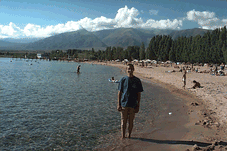 Tashblak – ‘the land of stones’, to my right a motorway services with a difference. Joe’s Yurt Cafe is a surreal mix – fizzy American cola and traditional chai both served in a bozui (Krygyz Yurt literally meaning ‘white house’). The waitresses are dressed for a Manhattan disco and outside a stuffed Ibex succumbs to the moths.
Tashblak – ‘the land of stones’, to my right a motorway services with a difference. Joe’s Yurt Cafe is a surreal mix – fizzy American cola and traditional chai both served in a bozui (Krygyz Yurt literally meaning ‘white house’). The waitresses are dressed for a Manhattan disco and outside a stuffed Ibex succumbs to the moths.
I’m due to meet the musician Saparbek but on arrival in Balykchy, I receive the sad news that he unexpectedly had to go to hospital in Biskek. His son tells me it is not too serious and I will see him in Biskek tomorrow – all part of life’s rich tapestry.
Instead I sample Lake Iyssk-Kul – it’s wonderfully relaxing swimming surrounded by Alpine-like peaks. When I emerge I experience a bout of the shivers – apparently this is normal – a lady from one of the bozui gives me some free chai and a blanket and I soon recover.
Tomorrow back to Biskek in the imperial Nomadmobile and the wonderful music of Kasmabetov.
Day 9 – Red Tape Hell, Musical Heaven
Posted by Musical Nomad in Daily Blog on August 6, 1997
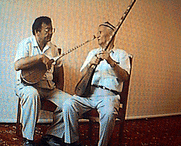 Having been out of action for a while I have not been able to tell you about our meeting with Pattahon Mamadaliev. Sometimes it’s difficult to interview musicians here because of their modesty . if you ask them about themselves they will naturally represent themselves in a very humble way. Pattahon is a good example of this.A respected maqam performer he is particularly famous for his wedding singing in the Fergana style. He is professor at Tashkent state Conservatoire and has performed numerous times on TV and Radio. In fact, the people working in our hotel were thoroughly surprised to see him sitting in their dining room. Perhaps the thing that most distinguishes him is his status as a composer. Pattahon was the first musician to be awarded the honorary title of Hafiz by the new administration after independence. This title is used in the Islamic World to describe one who has learned the Koran by heart, but it can also refer to a master musician. Pattahon is not only an interpreter, he also composes maqam music and texts.
Having been out of action for a while I have not been able to tell you about our meeting with Pattahon Mamadaliev. Sometimes it’s difficult to interview musicians here because of their modesty . if you ask them about themselves they will naturally represent themselves in a very humble way. Pattahon is a good example of this.A respected maqam performer he is particularly famous for his wedding singing in the Fergana style. He is professor at Tashkent state Conservatoire and has performed numerous times on TV and Radio. In fact, the people working in our hotel were thoroughly surprised to see him sitting in their dining room. Perhaps the thing that most distinguishes him is his status as a composer. Pattahon was the first musician to be awarded the honorary title of Hafiz by the new administration after independence. This title is used in the Islamic World to describe one who has learned the Koran by heart, but it can also refer to a master musician. Pattahon is not only an interpreter, he also composes maqam music and texts.
I always enjoy watching older musicians who have played for years, they often have a minimalist style, an economy of expression. Pattahon plays as if his tanbur is a part of him and his voice still retains a power which belies his seventy years. Interestingly when we asked about the age of the tanbur he said it was not old, only fifty years.
 As Pattahon’s life spans much of the period of Soviet rule in Uzbekistan I was keen to ask him about the changes that had come about. Both he and Abdurahim were clear that it had been an ill conceived experiment on the part of the Russians to try to change the musical tradition here. They felt it to be a tribute to the strength of the music and the peoples’ feeling for it that it had survived. Sasha our interpreter and musicologist companion pointed out that this viewpoint was fairly nationalistic and not necessarily representative of all musicians in the country, although there is much evidence that Soviet Cultural Policy had set out to repress the music. Sasha can be heard translating this viewpoint in an excerpt from the interview.This day was to be special for the project. A high ranking official from the Ministry of Foreign Affairs was going to make customs give us our satellite phone. We left for the airport at 9 am in triumphant frame of mind believing we would return within the hour. At 2 pm two bedraggled people walked through the door, black satellite phone in hand. We had been through red tape hell. The country may have reached independence but the old Russian way of doing things remains fully intact. An endless stream of grey concrete ‘huts’ scattered randomly around a wide, bland pot-holed road leading away from the airport. Sleepy Army soldiers guard rusty gates and several stages of payment, slips of paper and rubber stamps get you in.
As Pattahon’s life spans much of the period of Soviet rule in Uzbekistan I was keen to ask him about the changes that had come about. Both he and Abdurahim were clear that it had been an ill conceived experiment on the part of the Russians to try to change the musical tradition here. They felt it to be a tribute to the strength of the music and the peoples’ feeling for it that it had survived. Sasha our interpreter and musicologist companion pointed out that this viewpoint was fairly nationalistic and not necessarily representative of all musicians in the country, although there is much evidence that Soviet Cultural Policy had set out to repress the music. Sasha can be heard translating this viewpoint in an excerpt from the interview.This day was to be special for the project. A high ranking official from the Ministry of Foreign Affairs was going to make customs give us our satellite phone. We left for the airport at 9 am in triumphant frame of mind believing we would return within the hour. At 2 pm two bedraggled people walked through the door, black satellite phone in hand. We had been through red tape hell. The country may have reached independence but the old Russian way of doing things remains fully intact. An endless stream of grey concrete ‘huts’ scattered randomly around a wide, bland pot-holed road leading away from the airport. Sleepy Army soldiers guard rusty gates and several stages of payment, slips of paper and rubber stamps get you in.
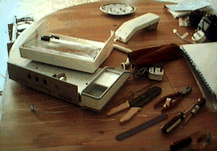
Over a roaring fire a large wok containing gallons of water. Lumps of dirty raw meat and vegetables, sit bubbling away in the middle of one of the yards – who is it for? The atmosphere of the place is slow and still, certainly not an area bubbling with efficiency. The various stages that Uzbekistan customs ask you to go through to acquire your own property is excruitiatingly painful when like us, you are in a rush. The paperwork and arguments burn irretrievably into the memory of all who pass through each ‘hut of frustration’.Though I’m still unwell, I’m keen to see how the new satellite is shaping up. I descend the stairs to find Gary and Paul surrounded by 100 pieces of wreckage – I can’t believe it, the replacement satellite has possibly been corrupted in transit and they are trying to trace an obvious fault. Despite all their efforts the team cannot find one, desperate calls to England are hampered when we can’t get a phone line. I retire to a safe distance, Gary and Paul are not happy. Ten minutes later I am awoken by a combined banging and throbbing – what now? Peering through the door I see Gary manfully priming a petrol generator and Paul planting an earth spike in the dusty courtyard. There wasn’t enough current in the local electricity supply to even work a soldering iron, so this is the solution – make your own electricity. It’s bizarre seeing all this sophisticated satellite gear driven by a petrol generator.
We are told a third satellite transmitter will be hand delivered in a few days to Bukhara. Please stick with us we are doing everything we can, normal ‘service’ will commence shortly.
Day 4 – Let the music and musical instruments be the bridge between the peoples of the World
Posted by Musical Nomad in Daily Blog on August 2, 1997
“Let the music and musical instruments be the bridge between the peoples of the World…You are the ambassadors and I wish you success” Izbazar Balbazulov – Director of Museum of Kazak Musical Instruments
 The Minister of Culture pulls some strings. Arranged at the last minute, here we are in the presence of two great virtuosi back in the Museum of Kazak Musical Instruments. We are expectant of good playing, though nothing could prepare us for the brilliance of the emotional journey to follow.
The Minister of Culture pulls some strings. Arranged at the last minute, here we are in the presence of two great virtuosi back in the Museum of Kazak Musical Instruments. We are expectant of good playing, though nothing could prepare us for the brilliance of the emotional journey to follow.
 He had arranged for us to meet one of the greatest exponents of the kobuz. This was an instrument that none of us knew much about so we crammed ourselves and our gear into the first Lada that would stop and headed for Panfilov park. Everywhere in Almaty people have been extremely helpful to us. They seem eager that their arts and culture are represented. This has been wonderful, but has made us aware of having a responsibility towards the artists that we meet. This spirit of helpfulness manifested itself in two musicians – Raushan Obrazbaeva the kobuz player and Aygul Ulkenbaeva a dombra player. We knew we were pushing our luck to record, film and interview them in the time that we had, yet still do them justice.
He had arranged for us to meet one of the greatest exponents of the kobuz. This was an instrument that none of us knew much about so we crammed ourselves and our gear into the first Lada that would stop and headed for Panfilov park. Everywhere in Almaty people have been extremely helpful to us. They seem eager that their arts and culture are represented. This has been wonderful, but has made us aware of having a responsibility towards the artists that we meet. This spirit of helpfulness manifested itself in two musicians – Raushan Obrazbaeva the kobuz player and Aygul Ulkenbaeva a dombra player. We knew we were pushing our luck to record, film and interview them in the time that we had, yet still do them justice.
 As we heard Aygul tuning her dombra we knew this was special. It was clear from the way that she handled her instrument that she was a virtuoso, not a folkloric performer of ‘museum’ music. As she began I was immediately struck by her poise and grace. Just like master musicians anywhere in the world, she transcended the apparent limitations of her instrument. Time stood still and we forgot that we were listening to a two stringed instrument, this music seemed universal. Paul came in from next door where he had been monitoring the recording, visibly paler. This was too good to miss, we just had to record it all. Aygul’s playing style is very extrovert and almost choreographed. She uses magnificent hand gestures to illustrate her music. It would be easy to make comparisons with extravagant concert pianists, but I felt this to be an integral part of her personal playing style. With her fully chromatic dombra she takes the instrument to new heights of expression. Her rasguedo strumming is flamenco in rhythm and fire. Her wide vibrato is almost as outrageous as the whammy bar on a Fender Stratocaster. Perhaps Aygul is a Segovia of the Dombra, extending its repertoire and range of tone colour, taking it to a new audience. This was very definitely classical music. There were no folk songs nostalgically invoking bygone eras, it was pure instrumental music. The drama of watching an instrumentalist weave a story in sound transcends any historical, national or cultural label.
As we heard Aygul tuning her dombra we knew this was special. It was clear from the way that she handled her instrument that she was a virtuoso, not a folkloric performer of ‘museum’ music. As she began I was immediately struck by her poise and grace. Just like master musicians anywhere in the world, she transcended the apparent limitations of her instrument. Time stood still and we forgot that we were listening to a two stringed instrument, this music seemed universal. Paul came in from next door where he had been monitoring the recording, visibly paler. This was too good to miss, we just had to record it all. Aygul’s playing style is very extrovert and almost choreographed. She uses magnificent hand gestures to illustrate her music. It would be easy to make comparisons with extravagant concert pianists, but I felt this to be an integral part of her personal playing style. With her fully chromatic dombra she takes the instrument to new heights of expression. Her rasguedo strumming is flamenco in rhythm and fire. Her wide vibrato is almost as outrageous as the whammy bar on a Fender Stratocaster. Perhaps Aygul is a Segovia of the Dombra, extending its repertoire and range of tone colour, taking it to a new audience. This was very definitely classical music. There were no folk songs nostalgically invoking bygone eras, it was pure instrumental music. The drama of watching an instrumentalist weave a story in sound transcends any historical, national or cultural label.
 These are not every-day experiences, and my head buzzed with questions. I hadn’t realised there was a living and vibrant classical tradition in Kazakstan, with composers writing for traditional instruments. Essentially the classical music seems to have developed and refined the folk art form rather than losing contact with it entirely as seems to have happened in the West. This should be seen as a natural process, it has happened all over the world. It seems to be part of urban life, and increasing sophistication. It would be simplistic to describe this as the influence of ‘Russification’, although Russia has clearly been a huge influence here. We should not be bemoaning the loss of ‘traditional’ music, but celebrating the survival of a distinctly Kazak form of musical expression.
These are not every-day experiences, and my head buzzed with questions. I hadn’t realised there was a living and vibrant classical tradition in Kazakstan, with composers writing for traditional instruments. Essentially the classical music seems to have developed and refined the folk art form rather than losing contact with it entirely as seems to have happened in the West. This should be seen as a natural process, it has happened all over the world. It seems to be part of urban life, and increasing sophistication. It would be simplistic to describe this as the influence of ‘Russification’, although Russia has clearly been a huge influence here. We should not be bemoaning the loss of ‘traditional’ music, but celebrating the survival of a distinctly Kazak form of musical expression.
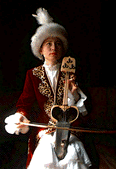 Raushan now took the stage to play the kobuz. Both musicians had been wearing traditional costume, and Raushan looked extraordinary in her long embroidered velvet gown with fur trimmed hat complete with shamanic-looking feathers. Her two-stringed horse hair fiddle is capable of creating almost unbelievably intense sounds. Whereas Aygul had been outgoing and virtuosic in her performance style, Raushan was introspective, as if summoning up ancestral spirits. She plays with closed eyes and rocks like a pendulum, in the dim light of the museum. I feel I’m in the presence of something very, very special. The sound of the kobuz is at times very close to the human voice. The emotional impact is immediate, it almost wails sometimes and it breaks your heart. We were astounded, not just by technical ability, but by the intensity and passion of her playing. The sound seemed to come from everywhere, to embrace you. Multiphonic effects brought to mind Mongolian overtone singing, primal sounds that were curiously abstract, impossible to notate. Simultaneously beautiful and terrifying. Raushan is able to move, in the space of one bow, from sorrowful and restrained Shostokovichian cello to guttural animal scream. I thought of Paul next door with his headphones turned up, and wondered what he must have been thinking. Once again all our expectations had been confounded. Gary pointed out during the performance that some of the music sounded very contemporary and accessible, and yet the pieces were hundreds of years old.
Raushan now took the stage to play the kobuz. Both musicians had been wearing traditional costume, and Raushan looked extraordinary in her long embroidered velvet gown with fur trimmed hat complete with shamanic-looking feathers. Her two-stringed horse hair fiddle is capable of creating almost unbelievably intense sounds. Whereas Aygul had been outgoing and virtuosic in her performance style, Raushan was introspective, as if summoning up ancestral spirits. She plays with closed eyes and rocks like a pendulum, in the dim light of the museum. I feel I’m in the presence of something very, very special. The sound of the kobuz is at times very close to the human voice. The emotional impact is immediate, it almost wails sometimes and it breaks your heart. We were astounded, not just by technical ability, but by the intensity and passion of her playing. The sound seemed to come from everywhere, to embrace you. Multiphonic effects brought to mind Mongolian overtone singing, primal sounds that were curiously abstract, impossible to notate. Simultaneously beautiful and terrifying. Raushan is able to move, in the space of one bow, from sorrowful and restrained Shostokovichian cello to guttural animal scream. I thought of Paul next door with his headphones turned up, and wondered what he must have been thinking. Once again all our expectations had been confounded. Gary pointed out during the performance that some of the music sounded very contemporary and accessible, and yet the pieces were hundreds of years old.
 I managed to find a moment to sit down with Raushan to ask her about the music. Is the kobuz the shaman’s fiddle? Are the attached jingles a vestigial shaman’s rattle? Can ancient Shamanic music connect with modern audiences? Join us tomorrow – let us have your views.
I managed to find a moment to sit down with Raushan to ask her about the music. Is the kobuz the shaman’s fiddle? Are the attached jingles a vestigial shaman’s rattle? Can ancient Shamanic music connect with modern audiences? Join us tomorrow – let us have your views.
The curator Izbazar Balbazulov is a warm and enthusiastic man. He is extremely proud of his museum and rightly so. We gather with Alia in his kingdom, surrounded by paintings of Kazak greats. Musical instruments overflow from the shelves. As Gary and Paul fill in his guest book with good wishes and thanks, Izbazar points to a very special entry: President Yeltzin dropped by, back in 1991. Our gratitude is evident and he responds:”Let the music and musical instruments be the bridge between the peoples of the World…You are the ambassadors and I wish you success”.

He plays his dombra, Kathrin buys a kobuz, Jan blows on a hollowed out wooden Kazak ney, Paul checks his rushes, Gary checks his flys. On we go.
The musicians we heard today are innovators and trail blazers with a strong sense of identity.
Tomorrow I hope for a different perspective, I interview Alia, our interpreter about her Rhythm and Blues band, a young persons ‘take’ on Kazak music.
 I almost didn’t meet Aygul. As soon as I arrived in the village of Saty I was told of a dombra player I simply must hear. “Not another dombra player” went the cry. What a wonderful surprise then to meet a young girl of thirteen with such talent and charisma.
I almost didn’t meet Aygul. As soon as I arrived in the village of Saty I was told of a dombra player I simply must hear. “Not another dombra player” went the cry. What a wonderful surprise then to meet a young girl of thirteen with such talent and charisma.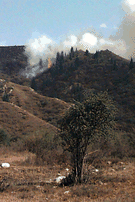 With very little to signify a transition, a row of houses appear. The town stretches for about a mile, the wide road lined on each side by wooden farm and administrative building. Next to a large yellow school a wooden hut doubles as the main store. We approached and bought drinks. We asked the shopkeeper if there are any local musicians. Moldira, our interpreter, scribbled down three names. One is an old man who apparently sings. We went to his house. A mad wolf-like dog attacked me. I then learned that the old man is ill and cannot be seen. I suspected the other contacts would prove as fruitless. It was now the hottest part of the day and we were trying to track down the second contact. Local people in the street seemed to point in the same direction when we ask. A group of teenagers passed us with a guitar. The guitar has a skull etched into the back and the boys also pointed in the same direction.
With very little to signify a transition, a row of houses appear. The town stretches for about a mile, the wide road lined on each side by wooden farm and administrative building. Next to a large yellow school a wooden hut doubles as the main store. We approached and bought drinks. We asked the shopkeeper if there are any local musicians. Moldira, our interpreter, scribbled down three names. One is an old man who apparently sings. We went to his house. A mad wolf-like dog attacked me. I then learned that the old man is ill and cannot be seen. I suspected the other contacts would prove as fruitless. It was now the hottest part of the day and we were trying to track down the second contact. Local people in the street seemed to point in the same direction when we ask. A group of teenagers passed us with a guitar. The guitar has a skull etched into the back and the boys also pointed in the same direction. We followed a road through the dusty, cattle infested streets. There was an air of sleepiness about the town. Occasionally a wagon filled with hay to dangerous levels careered carelessly through the narrow roads. We stopped near a large metal gate. Moldira peered over the top and confronted an old lady. After a short conversation I found out that this is a musical home. The whole family play dombra and sing. The daughter has won competitions and the eldest brother, currently working in the field, plays weddings and is well known to everyone in the village. We told the old lady, Salima about our project and who we are. She seemed almost expectant of our arrival. She invited the whole team with full equipment into her garden, her house, her world. A small girl in school uniform skipped towards the house. The garden is large. There are stables, small orchards and white clay ovens for cooking and bread making. This family like many others in this area are self sufficient. Salima asked us to take our shoes off and come into the house.
We followed a road through the dusty, cattle infested streets. There was an air of sleepiness about the town. Occasionally a wagon filled with hay to dangerous levels careered carelessly through the narrow roads. We stopped near a large metal gate. Moldira peered over the top and confronted an old lady. After a short conversation I found out that this is a musical home. The whole family play dombra and sing. The daughter has won competitions and the eldest brother, currently working in the field, plays weddings and is well known to everyone in the village. We told the old lady, Salima about our project and who we are. She seemed almost expectant of our arrival. She invited the whole team with full equipment into her garden, her house, her world. A small girl in school uniform skipped towards the house. The garden is large. There are stables, small orchards and white clay ovens for cooking and bread making. This family like many others in this area are self sufficient. Salima asked us to take our shoes off and come into the house. Inside the house we were shown around by Salima and introduced to her daughter, Aygul. Looking like any thirteen year old just back from school she greeted us politely. It was only a little later we discovered that she was the star musician of the family.
Inside the house we were shown around by Salima and introduced to her daughter, Aygul. Looking like any thirteen year old just back from school she greeted us politely. It was only a little later we discovered that she was the star musician of the family.